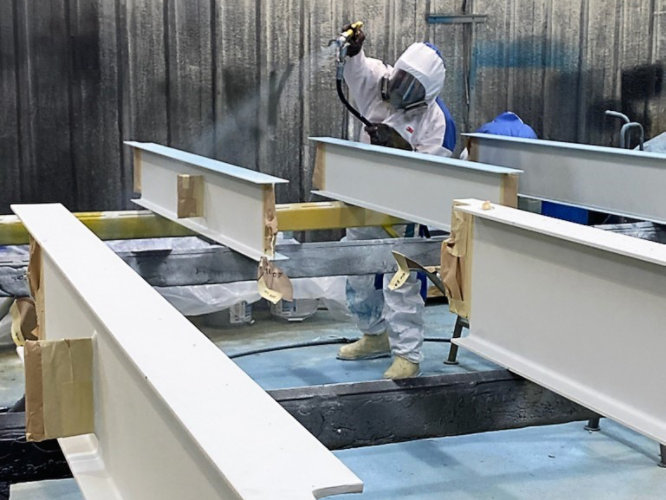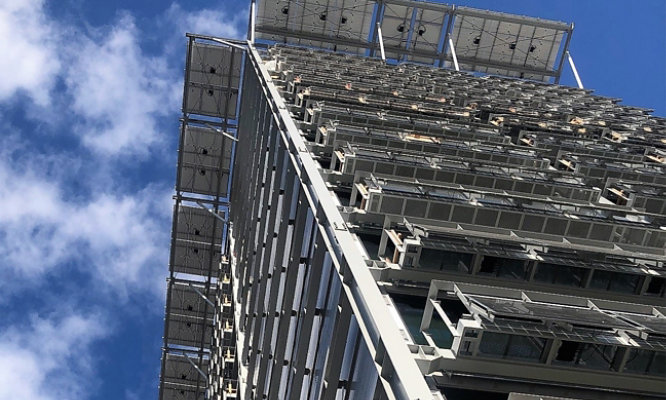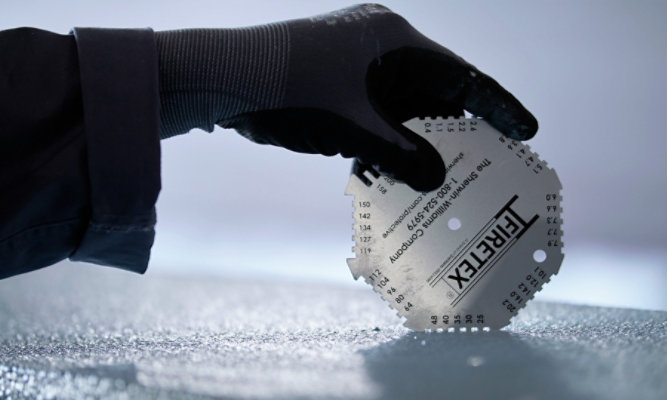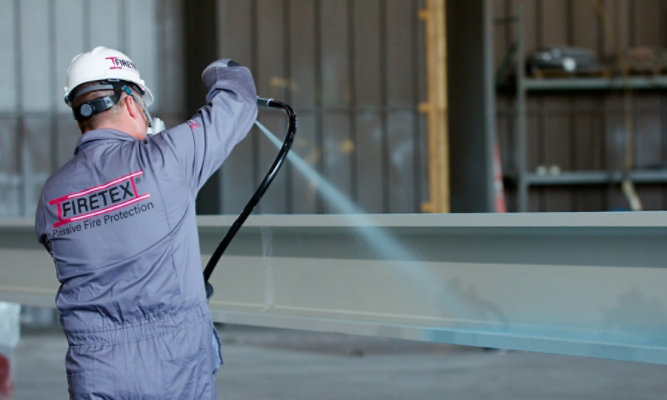Benefits of Shop-Applied Intumescent Fireproofing Coatings – 7 Key Advantages
Increase Quality and Efficiency with Off-Site, Shop-Applied Intumescent Coatings for Steel Fire Protection
by Max Tritremmel, Global Director – Fire Protection, Sherwin-Williams Protective & Marine

Changing Building Construction for the Better with Shop-Applied Intumescent Protective Coatings
Moving steel coating applications to an off-site facility offers key advantages, particularly for fireproofing coatings.
Optimal performance of these coatings to slow heat transfer during fires and mitigate corrosion requires proper application, and off-site facilities provide the highest level of control in this regard – not to mention in relation to aesthetics. This is due to the absence of various factors and conditions that can impact application at construction sites, making off-site environments an ideal location for ensuring the best coatings performance and finish quality. Then, at the construction site, precoated fireproofed structural steel arriving ready for assembly can significantly improve project quality, cost, length, scheduling, efficiency and safety.
Delivering fireproofed coatings directly to the construction site also enables developers to erect buildings on smaller site footprints (Figure 1). The recently completed 303 Battery building (Figure 2), built on an orphan lot in downtown Seattle, serves as a prime example. By having finished, fireproofed steel delivered to the site, the project maintained a smaller staging area, saved time and avoided the need for an on-site coatings shop.
Off-site fireproofing projects have also proven successful in iconic global structures like London’s Shard of Glass and Heathrow Airport’s Terminal 5, with hundreds of projects completed in recent decades.
With fireproofing coatings becoming more durable and easier to apply in off-site environments, applicators are able to provide maximum control for optimal performance and aesthetics for building owners. This article explores seven key benefits of off-site fireproofing, which has the potential to fundamentally change building construction for the better.
1. Increased Efficiency
Applying fireproofing coatings in a controlled off-site environment can accelerate construction schedules, leading to earlier project completions and faster returns on investment. With advanced plural component technology, intumescent coating systems applied off-site require fewer coats and can achieve high wet film builds in just one or two coats. These coatings also dry and cure quickly in a climate-controlled environment, enabling fast shop throughput.
By performing most of the coatings work off-site, the amount of coatings work required on-site is significantly reduced. For instance, a primer can be applied to steel in the shop and connection points can be masked off to leave those areas free from fireproofing coatings (Figure 3a). Then, on-site, applicators can simply spray or hand-trowel fireproofing coatings onto these “holdback” areas to achieve the required dry film thickness (DFT) (Figure 3b).
2. Less Risk, More Safety
Off-site application of fireproofing coatings allows for more accurate project scheduling as the process is not interrupted by on-site construction work. Fireproofed steel can be delivered to the jobsite ready for assembly, reducing site congestion and promoting safety while expediting the construction schedule. This results in fewer tradespeople and equipment needed on-site, lowering rental fees and boosting productivity.
Off-site application also enhances safety, as spraying steel at ground-level in a controlled shop reduces accidents and potential injuries compared to on-site application from lifts, scaffolding, or ladders. The reduction of on-site material handling needs further promotes safety.
Additionally, staging areas can be reduced in size, resulting in fewer interruptions at the street level.
3. More Control, Better Application
Off-site shops provide controlled environments that allow for optimal conditions for spraying, curing and inspecting – resulting in improved fireproofing application and surface preparation efficiency.
In addition, the close inspection and measurement of already-coated steel in a shop setting is more accurate. Indoor environments with controlled lighting, temperature and humidity result in a consistent film build and reduced overspray.
Various fireproofing methods and secondary procedures – including trowel finishing, finish rolling, rasping, sanding or grinding – benefit from not being subject to unpredictable conditions.
4. Superior Sustainability
Off-site fireproofing applications can be more environmentally friendly compared to on-site applications. Climate-controlled shops use exhaust fans to abate emissions, preventing the atmospheric release of volatile organic compounds (VOCs) in densely populated urban areas.
Additionally, in-shop applications allow for the use of coatings with low VOC emissions, reduced application thicknesses and fast drying times – which are all preferable and reduce the direct environmental impacts on applicators from mixing, heating and spraying coatings.
5. Makes Weather Irrelevant
Field applications can be impacted by unpredictable weather, which can compromise on-site spraying and curing schedules.
This includes coating structural steel within a temporary enclosure on the ground or in the air after erection – resulting in longer application times and more challenging surface preparation. Temporary structures take up space, can increase costs and require climate control.
Additionally, setting up scaffolding and containment tarps for already erected steel can be time-consuming and not always sturdy against wind or water, which can create application difficulties.
Furthermore, inclement weather can slow down a project and keep inspectors off scaffolding.
6. Showcases Steel, Better Aesthetics
Off-site application is ideal for thinner-film intumescent coatings that provide a paint-like finish and allow for creative steel exposure in designs employing Architecturally Exposed Structural Steel (AESS) (Figure 4).
These coatings are not only aesthetically pleasing but also reduce building material usage. Unlike traditional fire protection materials like sprayed fire-resistive materials (SFRMs) or cementitious fire protection, intumescent coatings do not require additional materials to meet design objectives and can withstand weathering.
This results in more sustainable buildings with a sleeker look.
7. Fewer On-Site Repairs
Fireproofed steel can also be safely transported to construction sites as these coatings offer protection from corrosion and weather, which is crucial given the exposure to varying temperatures, moisture and chemicals.
Intumescent coatings, particularly epoxy-based ones, are highly durable and can withstand mechanical impacts during movement, transportation and erection. These coatings can resist gouging, abrasions and bumping between steel members. If damage does occur, it can often be easily repaired by applying a small coating batch to the affected area.
Off-Site, Shop-Applied Intumescent Fireproofing is Optimal
High-performance coatings provide effective protection against fire and corrosion for structural steel in many types of buildings, such as residential, commercial and industrial structures.
With proper application, these coatings usually require minimal maintenance for a structure’s entire lifespan. By choosing to fireproof the steel off-site at an application shop instead of on-site, construction managers can achieve more precise and durable coating applications – resulting in numerous benefits, including improved quality, efficiency and cost-effectiveness.
Experience the Benefits of Shop-Applied Intumescent Fireproofing with Sherwin-Williams
At Sherwin-Williams, we are committed to protecting steel structures and providing life-saving protection from fires. Our line of proven intumescent fireproof coating systems can be applied off-site, resulting in additional quality control, lower overall cost and better aesthetics.
To learn more about our intumescent fire protective coatings, contact a Sherwin-Williams representative today.
ABOUT THE AUTHOR
Max Tritremmel is the Global Director of Fire Protection for Sherwin-Williams Protective & Marine. For more than 26 years, he has served the coatings industry as a sales representative, business leader, industrial painting contractor and now marketer. He is an SSPC Protective Coatings Specialist and an SSPC Level 3 Certified Coatings Inspector. Contact: Max.Tritremmel@sherwin.com
Figure 1. By transporting steel members that have been fully fireproofed to construction sites, it becomes possible to directly pull them off the truck and install them in the structure, reducing the need for on-site staging. Photo courtesy of Sustainable Living Innovations.
Figure 2. Coating the architecturally exposed structural steel (AESS) for 303 Battery at an off-site application shop offered several efficiencies and cost savings for the project. Photo courtesy of Sustainable Living Innovations.
Figure 3a & 3b. In a shop setting, applicators can prime and mask holdback areas (3a) before applying fireproofing coatings, simplifying on-site fireproofing (3b) of integrated steel members by on-site applicators. Photos courtesy of The Sherwin-Williams Company.
Figure 4. Applying fireproofing coatings within a controlled shop environment allows applicators to achieve the optimal finish for AESS. Photo courtesy of The Sherwin-Williams Company.
Discover More
Industry Expertise and Innovation
See how we help customers find customized solutions for their project and application challenges.
Our Fire Protection Expertise
Explore our industry solutions and technology to help protect your assets.
LEARN MOREProduct Lookup
Find out more about our innovative coatings for a variety of industries.
FIND A PRODUCT

